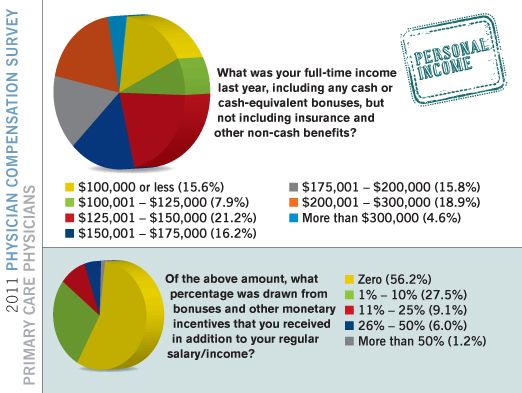- Clinical Technology
- Adult Immunization
- Hepatology
- Pediatric Immunization
- Screening
- Psychiatry
- Allergy
- Women's Health
- Cardiology
- Pediatrics
- Dermatology
- Endocrinology
- Pain Management
- Gastroenterology
- Infectious Disease
- Obesity Medicine
- Rheumatology
- Nephrology
- Neurology
- Pulmonology
How to Boost Your Compensation
Management makes all the difference when it comes to your income. Focus on delegation, billing and collections, and payer management to improve your compensation-not just on seeing more patients.

Late last year, ConsultantLive published its first-ever physician compensation data.
How much do primary care physicians make?
Well, it’s all over the map.
Primary care physicians are as likely to earn under $100,000 a year as they are to earn over $175,000 a year. And some are making more than $200,000 a year.
So what’s up with the rich guys? Are they smarter? Better clinicians? In larger practices? Do they have double your RVUs?
Probably none of the above. The days of getting a golden ticket by going on-salary with a hospital or large group practice are long gone; practically everyone works on a productivity basis. And most primary care physicians are pretty much maxed out in terms of RVUs. You’ve all been about as busy as you can stand to be for years.
The difference is business management. Some practices simply bill for and keep more of every dollar they earn.
Now, I’ve consulted with enough practices to know that some of you have thrown up your hands. What with payers dropping reimbursement (http://www.physicianspractice.com/fee-schedule-survey) and malpractice through the roof, you think there is nothing you can do. Well, have hope. Some folks are making $200,000, and you can get closer to that than you might think.
Improving your practice from a business perspective can be complex, but here are some surprisingly common mistakes I’ve seen. You can start here to improve your earnings:
1. Check your charges. I know that payers will only pay based on their own fee schedule; that makes it seem like your charges don’t matter. But I’ve been in practices where the physicians charge less than the payer’s fee schedule. When you submit a bill, think they offer to make up the difference? Fat chance. Make sure you are charging more than the payers’ fee schedule, especially if you do worker’s comp.
2. Code right. Boring, but important. A 99214 pays, on average, $25 more than a 99213. If you can accurately charge the 99214 for 5 patients a week, that’s $6,500 more a year for no more work. I am not saying, of course, that you should charge the more complex code willy-nilly. But it is not uncommon for physicians to have so little understanding of the rules that they routinely charge 99213 just to play it safe, even if the 99214 is perfectly justified. Grab your biller’s CPT book and read the passages about Evaluation and Management visits.
3. Bill fast. Your payer claims should go out electronically and should go out daily. Every day wasted impacts your cash flow, and paper claims waste time and breed inaccuracy. Patient bills should go out every week, and no patient account should be open longer than 90 days. I’ve been in practices where patient billing waits until someone has time to do it. No way. In the days of high patient deductibles and more self-pay, those bills are important.
4. Understand your overhead. Too many practices are penny-wise and pound-foolish. Good business is not about ratcheting down your overhead. It’s about investing to get a better return. If your front-desk person has more experience, knowledge and charm than average and thus can collect more copays and deductibles at the time of service, it might well make sense to be willing to pay more to keep or hire her. You can pay her more and still make money off the deal. Sure, electronic billing and revenue cycle management (http://www.physicianspractice.com/revenue-cycle-management) software cost money, but many can so improve your collections that you can make back that money and more. It’s even generally true that practices with more staff earn more at the end of the day than practices with less staff. Sure, staff are expensive, but having enough staff means that you can spend more time in patient visits and less time doing paperwork and returning calls. Revenue goes up and more than counteracts the cost of the staff.
Every practice has its own business challenges. These are just to get you started thinking. The take-home point is that some primary care physicians really are making this business work. You can make it happen, too.
Share your secrets of success and management questions in the comment box below. Let’s help each other get better.
